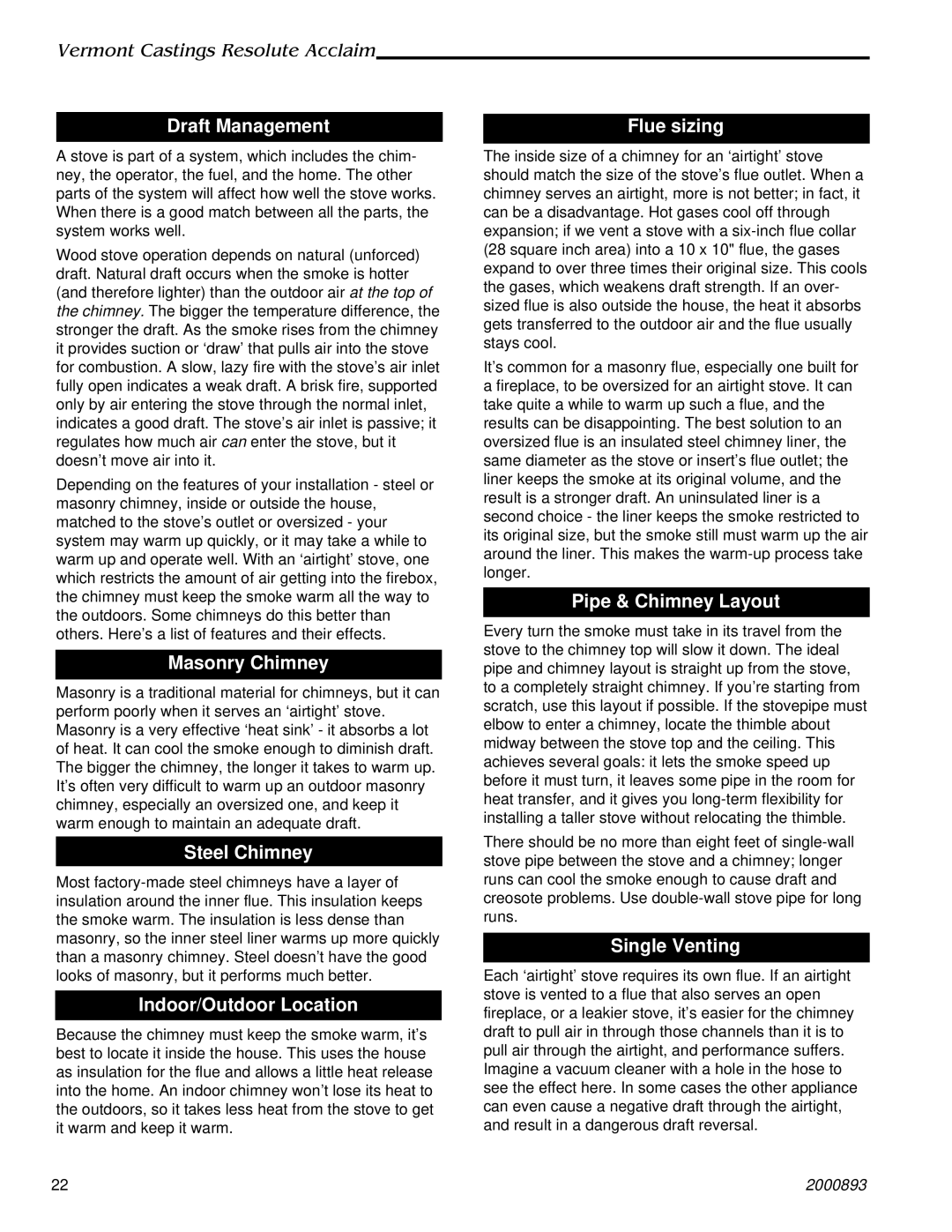
Vermont Castings Resolute Acclaim
Draft Management
A stove is part of a system, which includes the chim- ney, the operator, the fuel, and the home. The other parts of the system will affect how well the stove works. When there is a good match between all the parts, the system works well.
Wood stove operation depends on natural (unforced) draft. Natural draft occurs when the smoke is hotter (and therefore lighter) than the outdoor air at the top of the chimney. The bigger the temperature difference, the stronger the draft. As the smoke rises from the chimney it provides suction or ‘draw’ that pulls air into the stove for combustion. A slow, lazy fire with the stove’s air inlet fully open indicates a weak draft. A brisk fire, supported only by air entering the stove through the normal inlet, indicates a good draft. The stove’s air inlet is passive; it regulates how much air can enter the stove, but it doesn’t move air into it.
Depending on the features of your installation - steel or masonry chimney, inside or outside the house, matched to the stove’s outlet or oversized - your system may warm up quickly, or it may take a while to warm up and operate well. With an ‘airtight’ stove, one which restricts the amount of air getting into the firebox, the chimney must keep the smoke warm all the way to the outdoors. Some chimneys do this better than others. Here’s a list of features and their effects.
Masonry Chimney
Masonry is a traditional material for chimneys, but it can perform poorly when it serves an ‘airtight’ stove. Masonry is a very effective ‘heat sink’ - it absorbs a lot of heat. It can cool the smoke enough to diminish draft. The bigger the chimney, the longer it takes to warm up. It’s often very difficult to warm up an outdoor masonry chimney, especially an oversized one, and keep it warm enough to maintain an adequate draft.
Steel Chimney
Most
Indoor/Outdoor Location
Because the chimney must keep the smoke warm, it’s best to locate it inside the house. This uses the house as insulation for the flue and allows a little heat release into the home. An indoor chimney won’t lose its heat to the outdoors, so it takes less heat from the stove to get it warm and keep it warm.
Flue sizing
The inside size of a chimney for an ‘airtight’ stove should match the size of the stove’s flue outlet. When a chimney serves an airtight, more is not better; in fact, it can be a disadvantage. Hot gases cool off through expansion; if we vent a stove with a
It’s common for a masonry flue, especially one built for a fireplace, to be oversized for an airtight stove. It can take quite a while to warm up such a flue, and the results can be disappointing. The best solution to an oversized flue is an insulated steel chimney liner, the same diameter as the stove or insert’s flue outlet; the liner keeps the smoke at its original volume, and the result is a stronger draft. An uninsulated liner is a second choice - the liner keeps the smoke restricted to its original size, but the smoke still must warm up the air around the liner. This makes the
Pipe & Chimney Layout
Every turn the smoke must take in its travel from the stove to the chimney top will slow it down. The ideal pipe and chimney layout is straight up from the stove, to a completely straight chimney. If you’re starting from scratch, use this layout if possible. If the stovepipe must elbow to enter a chimney, locate the thimble about midway between the stove top and the ceiling. This achieves several goals: it lets the smoke speed up before it must turn, it leaves some pipe in the room for heat transfer, and it gives you
There should be no more than eight feet of
Single Venting
Each ‘airtight’ stove requires its own flue. If an airtight stove is vented to a flue that also serves an open fireplace, or a leakier stove, it’s easier for the chimney draft to pull air in through those channels than it is to pull air through the airtight, and performance suffers. Imagine a vacuum cleaner with a hole in the hose to see the effect here. In some cases the other appliance can even cause a negative draft through the airtight, and result in a dangerous draft reversal.
22 | 2000893 |
